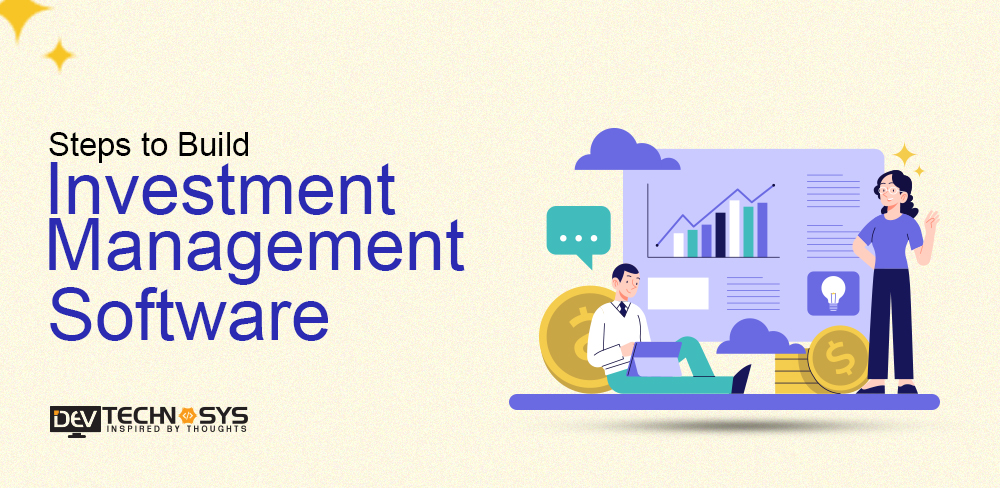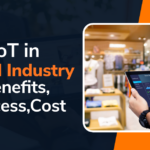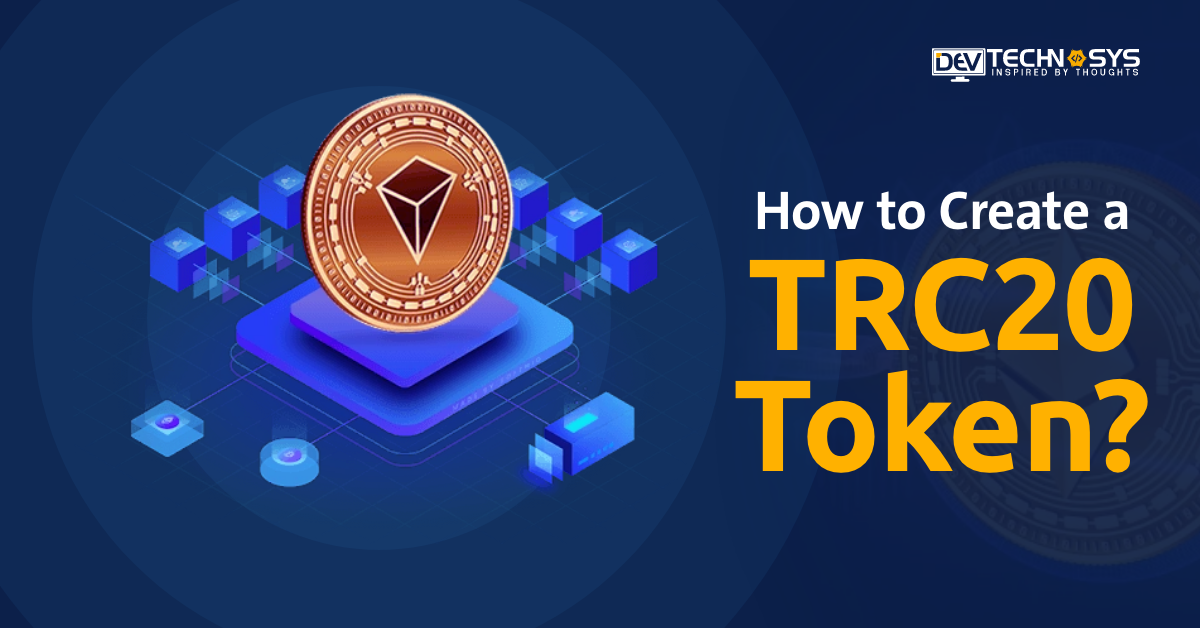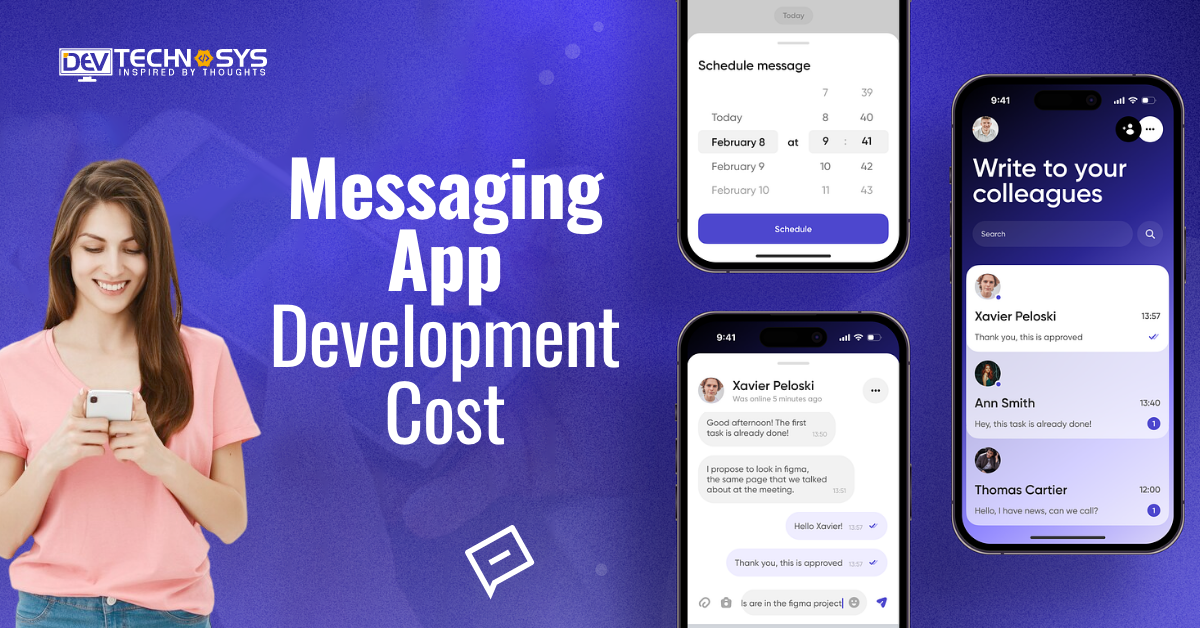Are you planning to build Investment Management Software? Read this blog to learn everything about the development of investment management software.
Investment Management Software will enter a dynamic, technologically advanced world in 2023. Investor demands are also expected to grow. The landscape of investment manager software has been transformed by the rapid integration of artificial intelligence, machine learning, as well as data-driven decision-making.
The integration of blockchain, the development of cryptocurrencies and the increasingly strict regulatory requirements have pushed investment management software up to new levels of compliance and safety.
Investment portfolio management software is a vital tool in the financial sector. It provides powerful tools and solutions to investment professionals, allowing them to manage their portfolios efficiently, analyze market data, and make informed decisions.
It is important to know the latest trends and best practices for building investment management software as 2023 approaches. Clients will enjoy a more engaging experience with real-time insight and intuitive interfaces. ESG factors are also taken into consideration while developing investing strategies.
This blog will cover the steps involved in building Investment Management Software, along with its costs, features, and other aspects.
Table of Contents
What is Investment Management Software?
It’s like having an intelligent financial advisor in your pocket without the fancy suits or condescending accents. This tool helps individuals and companies manage their investments better and more efficiently. This investment management system software can be a secret weapon for experienced investors or those just dipping their toes in the financial waters.
Investment Management Software includes a variety of tools and software for managing real estate investments. You must know that there are various types of investment custom software for business. It is designed to assist individuals, financial institutions, and investment professionals in efficiently managing and optimizing investment portfolios.
Market Stats of Investment Software
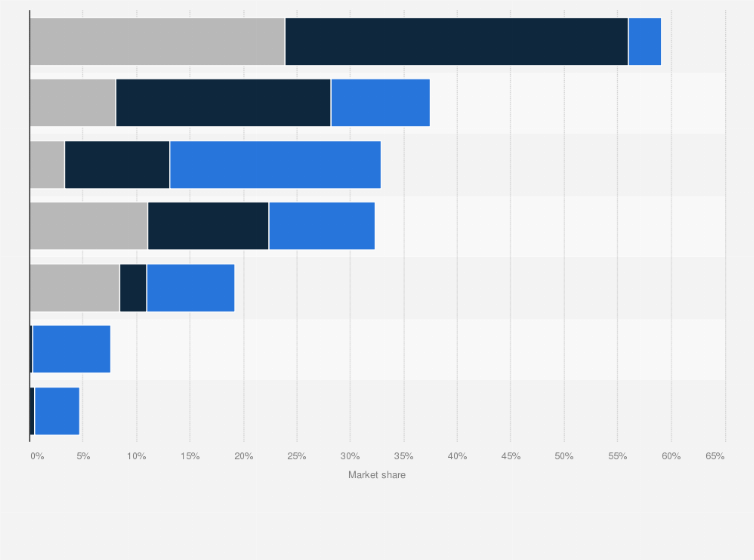
- In 2022, Orion was the most widely used financial software in the world for fee-only counseling and financial planning firms. For businesses that were both dual-registered advisory firms and financial planning firms, Albridge was the most widely used software. 32.1% of the market was owned by it.
- The global wealth management software market was valued at USD 4,27 billion in 2022. It is expected to grow with a CAGR of 13.9% between 2023 and 2030.
- Financial planning and investment advisory companies worldwide ranked CRM as the most valuable software in 2022.
- MoneyGuidePro Elite, an investment management software market, is the world’s most popular financial software as of 2022.
How to Build Investment Management Software?
As per the Enterprise Product Development Services provider, below is the step-by-step process to build investment management software. So let’s have a look:
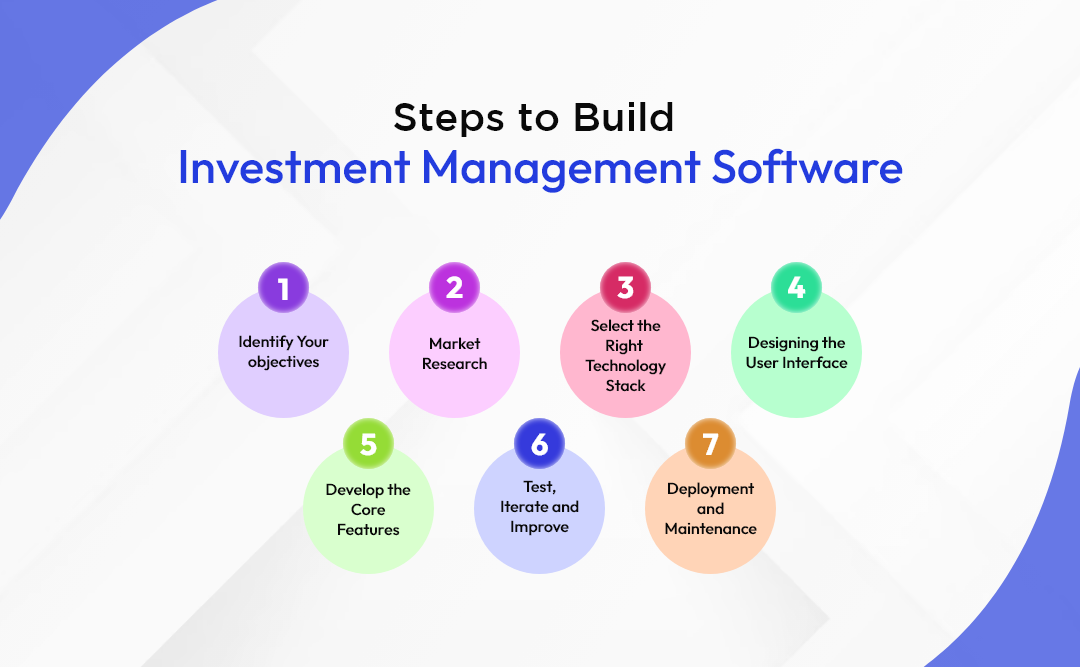
Step 1: Identify Your Objectives
Before you build investment management software development, you must be aware of your objectives. Which type of investing software are you planning to develop? Are you building it for a personal platform, a financial institution, or a robo advisory? Define the audience you are targeting and what features you would like to provide.
Step 2: Market Research
Understanding your users and competitors requires research. Look at existing investment fund management software for investment management to find out where the gaps are in the market. Gather input to discover more about the needs and preferences of future consumers. You may build investment management software for your business with the aid of this data.
Step 3: Select the Right Technology Stack
It is important to choose the right technology stack. Scalability, compatibility, and security are all important factors to consider. For better results, you can get assistance from a SaaS Development Services provider who would provide you with the right tech stack. Programming languages such as Python, Java, or C++; databases such as SQL or NoSQL; and cloud platforms like AWS or Azure are all common technologies used for investment software.
Step 4: Designing the User Interface
The UI of your software should be intuitive and easy to use. Wireframes and prototypes can be created in collaboration with UX designers. Focus on features such as portfolio tracking, risk analyses, and investment recommendations. Keep the interface simple and appealing.
Step 5: Develop the Core Features
Start by building the core functionality of your software. Ask the custom software development team to build the core functionality of your software. You may need to integrate data to gain access to real-time data on the market or use algorithms to optimize your portfolio. Or, you might want to implement security measures that protect sensitive financial data. Verify that your software is compliant with applicable regulations such as the GDPR or SEC guidelines.
Step 6: Test, Iterate and Improve
Test your software thoroughly to find and fix bugs, security issues, and usability problems. To gather feedback, consider alpha or beta testing. This feedback will help you improve your software’s performance and user satisfaction.
Step 7: Deployment and Maintenance
When you are confident that your software is stable, make it available to your intended users. Be prepared to deal with any problems that may arise. Update your software to reflect market changes and changing regulations. Customer support is essential to ensuring users have an enjoyable experience.
Key Features to Build Investment Management Software
In order to build effective investment management software, it is important to incorporate key features that satisfy the needs of individual investors as well as financial professionals. So, as per the software product development company, below are essential features that you should consider when creating investment management software.

1. User-friendly Interface:
The software must have a user interface that is intuitive and appealing. Users should be able to navigate easily through different sections, view their investment portfolios, and access information about investments without confusion.
2. Portfolio Tracking:
it is a fundamental feature. You may use it to control and monitor your financial portfolios. Users should have the ability to update and input their investment holdings and track performance. They should also be able to view historical data and make informed decisions.
3. Real-time Market Data:
It is important to integrate real-time feeds of market data for the latest information about stocks, bonds, and commodities. These data ought to be displayed in an understandable fashion, such as charts and graphs.
4. Investment Analytics:
It is important to offer robust analytical tools. Users should be able to access tools such as risk assessment, asset allocation, and performance analysis. Users are able to make knowledgeable investing selections because of these features.
5. Investment Research:
Access to comprehensive tools and reports. Financial news, analyst rankings, historical data, and research reports are all possible. Information is the key to success.
6. Automated Alerts and Rules:
Use automation to allow users to set rules and triggers that will automatically buy or sell assets. Offer customizable alerts to price changes, news, and portfolio milestones. So, if you want to integrate this feature into your software, then you must hire software developers.
7. Security:
Especially when it involves financial data, it is crucial. To protect the user’s information and transactions, implement robust encryption, multifactor authentication, and regular security audits. It is also important to comply with financial regulations.
8. Mobile Accessibility:
In the mobile-driven society of today, it is important that your software be accessible across a variety of devices including smartphones and tablet computers. Users on the move need a mobile app or responsive web design.
9. Customer Support:
Provide responsive channels of customer support, such as email, chat, or phone to help users with their questions or concerns. Customer support that is strong builds trust and encourages retention.
Benefits of Building an Investment Management Software
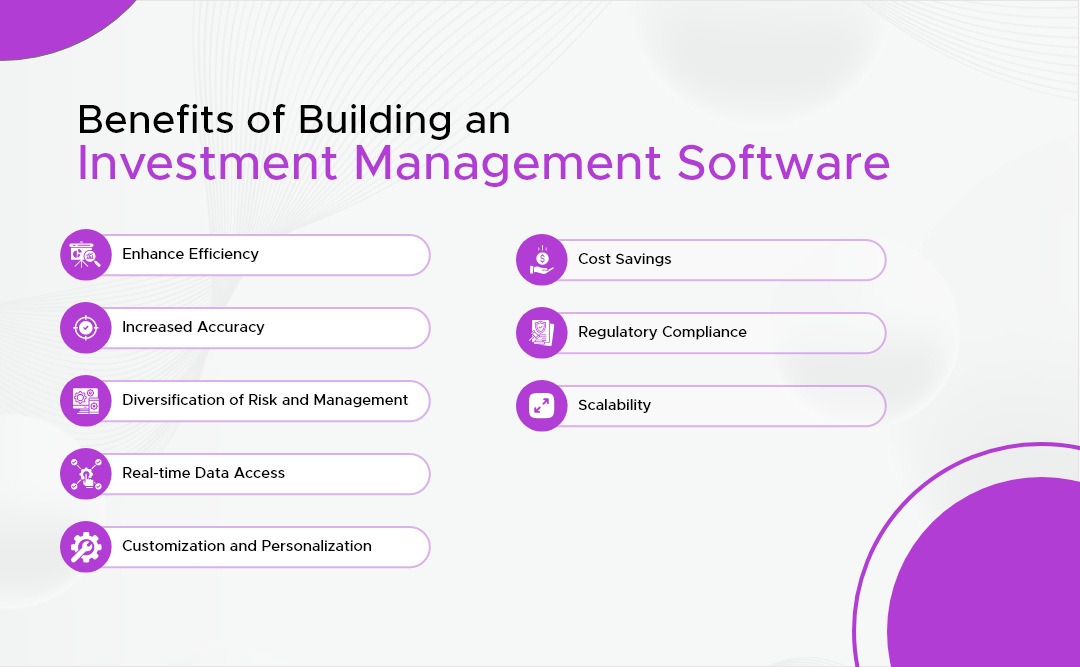
Now that you know the features of building investment management software, we will look at the benefits of developing it. So let’s check out:
1. Enhance Efficiency
Software for investment management streamlines financial operations. It automates tasks that used to be time-consuming or prone to error. Portfolio tracking, trade execution, and performance reporting are all included. Automation allows users to manage their investments efficiently and free up time for strategic decisions.
2. Increased Accuracy
In the world of finance, manual calculations can result in costly errors. Software for investment management, however, can perform complex calculations precisely. Accuracy is crucial when managing risk, tracking investment performance, and calculating taxes. Additionally, when you hire dedicated developers for building investment software, they can assist in developing software and help increase accuracy.
3. Diversification of Risk and Management
One of the key benefits of investment management software is portfolio diversification. The software analyzes investment options and can recommend a mix of assets that is balanced, which reduces the risk associated with a concentrated strategy. The software also offers tools for assessing and managing risk to ensure that investments are aligned with the user’s financial goals and risk tolerance.
4. Real-time Data Access
It is essential to have access to recent market information in the financial sector. Software for investment management provides users with up-to-date information about stock prices, economic indicators, and market trends. These data enable users to make informed and timely investment decisions. However, choosing the best software development company is vital for developing bespoke investment management software. You must choose wisely.
5. Customization and Personalization
Software for managing investments can be tailored to a person’s interests and goals. The software can be customized to meet the needs of each user. Users can specify their investment goals, risk tolerance, and time frame, and it will create personalized investment strategies. The software’s level of customization allows users to tailor their investments to fit their unique financial circumstances.
6. Cost Savings
For financial organizations, using investment management software can result in considerable cost reductions. The software reduces the amount of manual labor required for tasks like portfolio rebalancing, reporting, and other similar activities. The software can also reduce transaction costs by optimizing investments, minimizing fees, and minimizing trades.
7. Regulatory Compliance
To avoid penalties and legal issues, it is important to comply with financial regulations. Investment management software is designed to comply with relevant regulations such as Know Your Customer and Anti-Money Laundering requirements. This can help financial institutions to maintain a good reputation and avoid legal problems.
8. Scalability
Software for investment management can be scaled to meet the needs of growing portfolios and users. The investment management software for individuals can handle more assets and transactions, whether it is an individual investor managing multiple clients or a financial institution managing many clients.
Tech Stack to Build Investment Management Software
The technology stack is largely determined by the team composition, architecture, and features. If it is a wealth-management application, then we can expect it to always be available on the web and to be secured.
- Python’s Django as a backend
- React for the Frontend
- PostgreSQL for database management and caching, and Redis to cache data
- AWS Cloud Computing
- Nginx is a great tool for DevOps.
There are many tools and technologies available for the development of money and bill management apps. The tech team can choose from a variety of tools and technologies depending on the goals, features, and composition of the app.
Top 5 Investment Management Software

It is difficult to decide which investment portfolio management software is best for your company. This list provides an overview of the most popular portfolio management tools available today.
1. Mint
You can manage your personal money online using Mint, a service that lets you track your spending, make budgets, and keep an eye on your assets. The cloud-based investment management software has a user-friendly interface with a clean and simple design. Mint integrates with more than 2,000 financial institutions so that you can import data from your investment accounts.
2. Kubera
Kubera, a web-based tool for investment management, offers many features including asset allocation and portfolio analysis. This portfolio manager is as easy to use as an Excel spreadsheet. It covers global banks and brokerages, stocks, currencies, and equities.
You can make a strategy for your savings with the assistance of a retirement planner. Kubera is “contemporary” because of its crypto component, which allows you to track the value of both your crypto and traditional assets.
3. StockRover
StockRover’s Portfolio Manager is a great alternative for those who want to study their portfolio in greater depth and detail. You can use a spreadsheet, enter your brokerage data manually, or connect it.
4. Morningstar Portfolio Manager
Morningstar Portfolio Manager, a web-based tool for investment management, offers many features including portfolio analysis and asset allocation. The tool also has a retirement planner that helps you to create a savings plan. It is suitable for personal and business use. So, if you want to build investment management software like StackRover, then getting help from a startup solutions company would be helpful for you.
5. Quicken Premier 2022
One of the most recognizable names in stock portfolio management software is Quicken. Users of the desktop application Quicken Premier may track costs, handle investments, and make budgets. This desktop application also has features to track mortgages, credit cards, and loans. This tool is unique because it allows users to manage their finances from computers and smartphones.
Cost to Build Investment Management Software
The cost of custom software development for investment depends on many factors. These include the complexity, features, platforms, location, experience, and expertise of the development team.
As a rough estimation, the cost of building a basic Investment Management Software ranges from $8,000 up to $25,000. The software would have basic features like budget tracking, expense monitoring, and goal setting. Here is the table that shows the complexity of the software:
| Software Complexity | Cost estimation | Time Duration |
| Basic software | $8000-$13000 | 2-4 months |
| Moderate software | $15000-$20000 | 7 months |
| Complex software | $25000 | 9 months or more |
The cost can be higher if you want more advanced features, such as bill payment, investment tracking, financial planning, and integration of third-party services.
Also, the cost of building Investment Management Software will not be a one-time expense. Maintenance, updates and bug fixes are ongoing costs. So, if you want to know the exact cost of building investment management software, then you must consult with a reputed Fintech Software Development Services provider.
Conclusion
The development of wealth management software is a lucrative venture. People are more aware of their finances, and they need tools that can help them manage them. The market is still not saturated. There’s an opportunity to attract thousands by offering tools such as budgeting and financial planning, investing, or even budgeting.
It’s important to consider many details when developing a high-quality, functional, and user-friendly application. Even a brilliant concept depends on the team of techies who will implement it. If you want to find a team that is reliable, you should consider hiring a FIntech Software Development Company that has years of expertise in crafting robust software.
FAQ
1. How Much Time Does it Take to Build Investment Management Software?
The time to build investment management software depends on various factors. Usually, it takes around 3 to 8 months to develop software.
2. What Are the Types of Investment Platforms for Creating Investment Software?
There are six types of platforms for creating investment software. So let’s have a look at them:
- Crowdfunding Platform
- Brokerage platform
- Social trading solution
- P2P lending solution
- Crypto exchange solution
- Real estate investment system
3. How Much Does Software Developers Cost to Hire?
The cost to hire software developers would be around $15-$25. It can go beyond the level of expertise.

